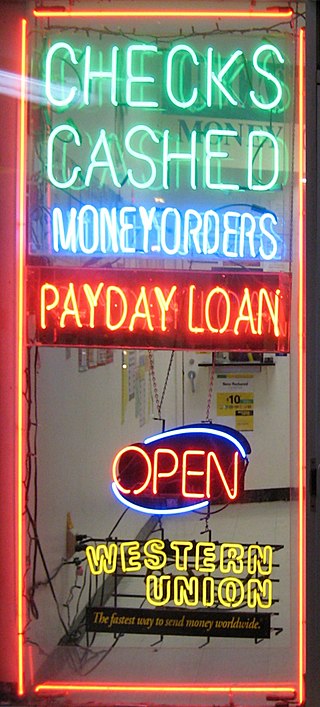Related Research Articles
A monopoly, as described by Irving Fisher, is a market with the "absence of competition", creating a situation where a specific person or enterprise is the only supplier of a particular thing. This contrasts with a monopsony which relates to a single entity's control of a market to purchase a good or service, and with oligopoly and duopoly which consists of a few sellers dominating a market. Monopolies are thus characterised by a lack of economic competition to produce the good or service, a lack of viable substitute goods, and the possibility of a high monopoly price well above the seller's marginal cost that leads to a high monopoly profit. The verb monopolise or monopolize refers to the process by which a company gains the ability to raise prices or exclude competitors. In economics, a monopoly is a single seller. In law, a monopoly is a business entity that has significant market power, that is, the power to charge overly high prices, which is associated with a decrease in social surplus. Although monopolies may be big businesses, size is not a characteristic of a monopoly. A small business may still have the power to raise prices in a small industry.

Price discrimination is a microeconomic pricing strategy where identical or largely similar goods or services are sold at different prices by the same provider in different market segments. Price discrimination is distinguished from product differentiation by the more substantial difference in production cost for the differently priced products involved in the latter strategy. Price differentiation essentially relies on the variation in the customers' willingness to pay and in the elasticity of their demand. For price discrimination to succeed, a firm must have market power, such as a dominant market share, product uniqueness, sole pricing power, etc. All prices under price discrimination are higher than the equilibrium price in a perfectly competitive market. However, some prices under price discrimination may be lower than the price charged by a single-price monopolist. Price discrimination is utilised by the monopolist to recapture some deadweight loss. This Pricing strategy enables firms to capture additional consumer surplus and maximize their profits while benefiting some consumers at lower prices. Price discrimination can take many forms and is prevalent in many industries, from education and telecommunications to healthcare.

A gratuity is a sum of money customarily given by a customer to certain service sector workers such as hospitality for the service they have performed, in addition to the basic price of the service.

Pricing is the process whereby a business sets the price at which it will sell its products and services, and may be part of the business's marketing plan. In setting prices, the business will take into account the price at which it could acquire the goods, the manufacturing cost, the marketplace, competition, market condition, brand, and quality of product.
Discounts and allowances are reductions to a basic price of goods or services.
The subscription business model is a business model in which a customer must pay a recurring price at regular intervals for access to a product or service. The model was pioneered by publishers of books and periodicals in the 17th century, and is now used by many businesses, websites and even pharmaceutical companies in partnership with the government.

Service economy can refer to one or both of two recent economic developments:
Predatory lending refers to unethical practices conducted by lending organizations during a loan origination process that are unfair, deceptive, or fraudulent. While there are no internationally agreed legal definitions for predatory lending, a 2006 audit report from the office of inspector general of the US Federal Deposit Insurance Corporation (FDIC) broadly defines predatory lending as "imposing unfair and abusive loan terms on borrowers", though "unfair" and "abusive" were not specifically defined. Though there are laws against some of the specific practices commonly identified as predatory, various federal agencies use the phrase as a catch-all term for many specific illegal activities in the loan industry. Predatory lending should not be confused with predatory mortgage servicing which is mortgage practices described by critics as unfair, deceptive, or fraudulent practices during the loan or mortgage servicing process, post loan origination.

Refund anticipation loan (RAL) is a short-term consumer loan in the United States provided by a third party against an expected tax refund for the duration it takes the tax authority to pay the refund. The loan term was usually about two to three weeks, related to the time it took the U.S. Internal Revenue Service to deposit refunds in electronic accounts. The loans were designed to make the refund available in as little as 24 hours. They were secured by a taxpayer's expected tax refund, and designed to offer customers quicker access to funds.
A mortgage broker acts as an intermediary who brokers mortgage loans on behalf of individuals or businesses.

TurboTax is a software package for preparation of American income tax returns, produced by Intuit. TurboTax is a market leader in its product segment, competing with H&R Block Tax Software and TaxAct. TurboTax was developed by Michael A. Chipman of Chipsoft in 1984 and was sold to Intuit in 1993.
Taxation in Indonesia includes income tax, value added tax and carbon tax.
Private banking is a general description for banking, investment and other financial services provided by banks and financial institutions primarily serving high-net-worth individuals (HNWIs) – those with very high income and/or substantial assets. Private banking is presented by those who provide such services as an exclusive subset of wealth management services, provided to particularly affluent clients. The term "private" refers to customer service rendered on a more personal basis than in mass-market retail banking, usually provided via dedicated bank advisers. It has typically consisted of banking services, discretionary asset management, brokerage, limited tax advisory services and some basic concierge services, typically offered through a gateway provided by a single designated relationship manager.

A business can use a variety of pricing strategies when selling a product or service. To determine the most effective pricing strategy for a company, senior executives need to first identify the company's pricing position, pricing segment, pricing capability and their competitive pricing reaction strategy. Pricing strategies and tactics vary from company to company, and also differ across countries, cultures, industries and over time, with the maturing of industries and markets and changes in wider economic conditions.
Tax-free shopping (TFS) is the buying of goods in another country or state and obtaining a refund of the sales tax which has been collected by the retailer on those goods. The sales tax may be variously described as a sales tax, goods and services tax (GST), value added tax (VAT), or consumption tax.

Brick and mortar is an organization or business with a physical presence in a building or other structure. The term brick-and-mortar business is often used to refer to a company that possesses or leases retail shops, factory production facilities, or warehouses for its operations. More specifically, in the jargon of e-commerce businesses in the 2000s, brick-and-mortar businesses are companies that have a physical presence and offer face-to-face customer experiences.
Pay what you can (PWYC) is a non-profit or for-profit business model which does not depend on set prices for its goods, but instead asks customers to pay what they feel the product or service is worth to them. It is often used as a promotional tactic, but can also be the regular method of doing business. It is a variation on the gift economy and cross-subsidization, in that it depends on reciprocity and trust to succeed.
Pay what you want is a pricing strategy where buyers pay their desired amount for a given commodity. This amount can sometimes include zero. A minimum (floor) price may be set, and/or a suggested price may be indicated as guidance for the buyer. The buyer can select an amount higher or lower than the standard price for the commodity. Many common PWYW models set the price prior to a purchase, but some defer price-setting until after the experience of consumption. PWYW is a buyer-centered form of participatory pricing, also referred to as co-pricing.

A cost of poverty, also known as a ghetto tax, a poverty premium, a cost of being poor, or the poor pay more, is the phenomenon of people with lower incomes, particularly those living in low-income areas, incurring higher expenses, paying more not only in terms of money, but also in time, health, and opportunity costs. "Costs of poverty" can also refer to the costs to the broader society in which poverty exists.

A value-added tax (VAT), known in some countries as a goods and services tax (GST), is a type of tax that is assessed incrementally. It is levied on the price of a product or service at each stage of production, distribution, or sale to the end consumer. If the ultimate consumer is a business that collects and pays to the government VAT on its products or services, it can reclaim the tax paid. It is similar to, and is often compared with, a sales tax. VAT is an indirect tax because the person who ultimately bears the burden of the tax is not necessarily the same person as the one who pays the tax to the tax authorities.
References
- ↑ Taylor, C. "The Economics of Sliding Scale Pricing". smallbusiness.chron.com. Small Business - Chron.com. Retrieved 2 July 2021.
- ↑ Banton, Caroline (21 August 2019). "Reading Into Sliding Scale Fees". Investopedia. Retrieved 2 July 2021.
- ↑ Pueblo.gsa.gov Archived 2008-12-08 at the Wayback Machine
- ↑ "Tickets without fees". Thursday, 24 August 2017